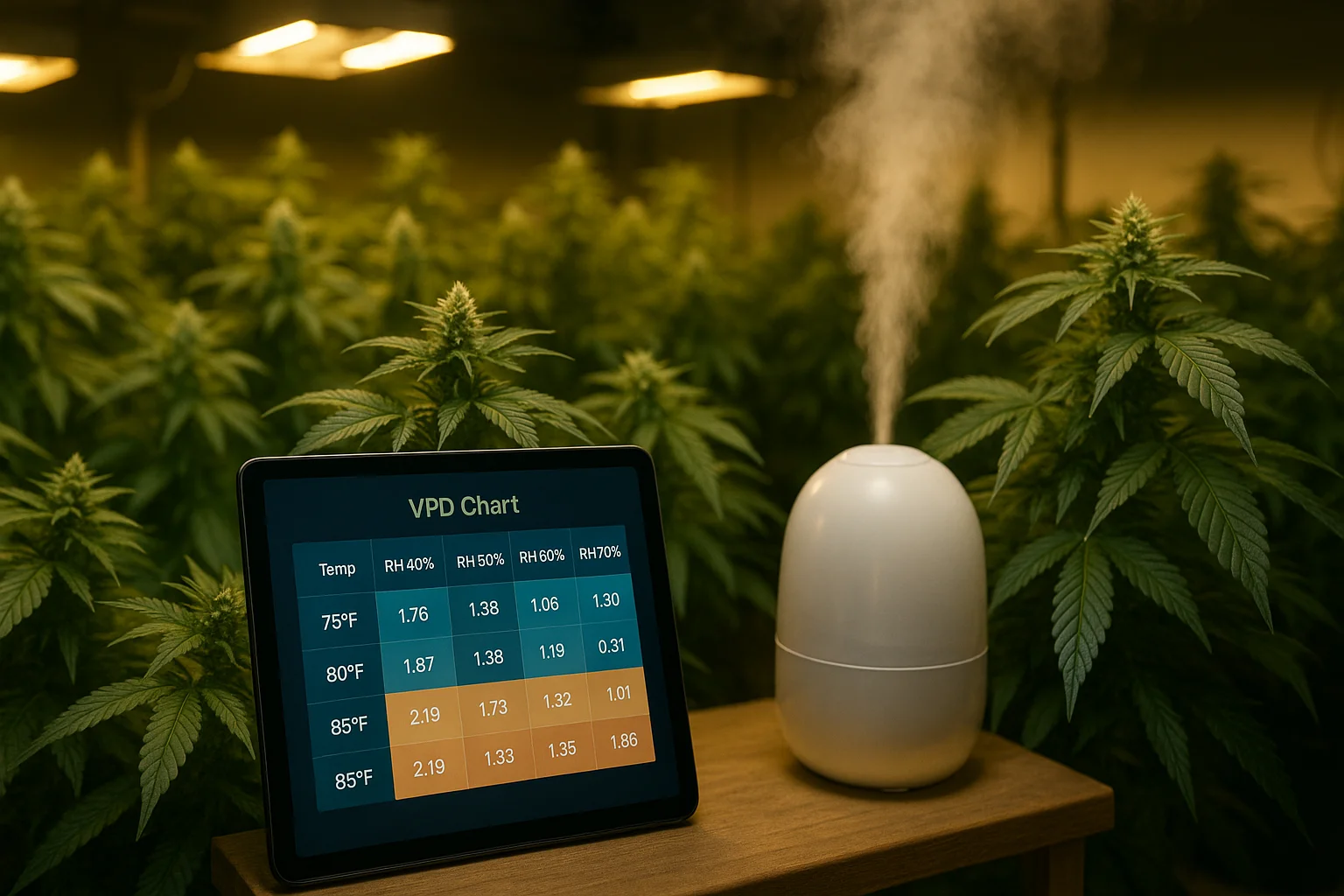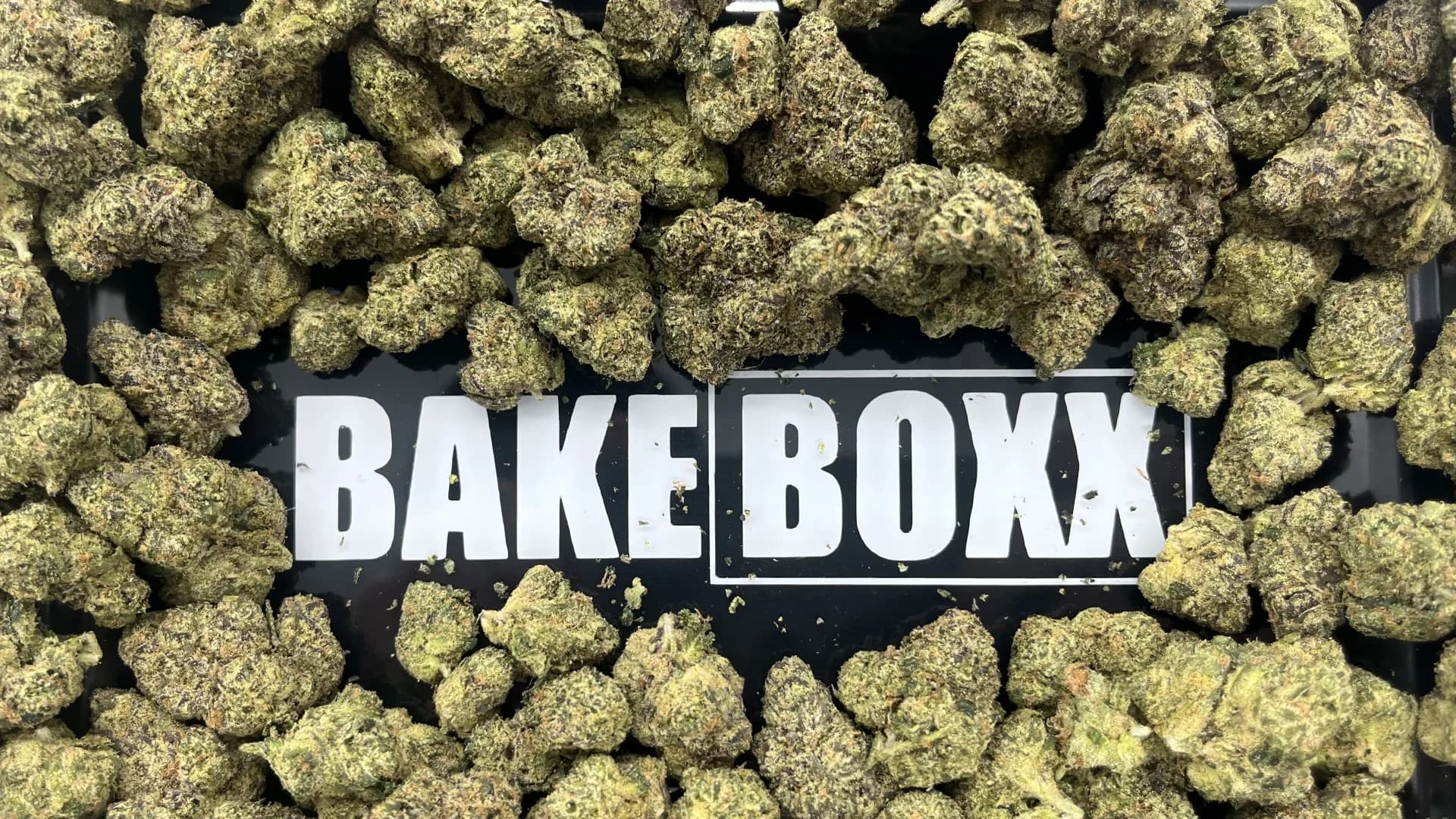🌿 VPD Chart for Cannabis: How Smart Growers Control the Grow Room
Quick Answer
VPD, or vapor pressure deficit, is one of the most overlooked yet powerful tools in cannabis cultivation. It tells you how plants interact with their environment—and when you dial it in, you unlock healthier growth, better yields, and fewer problems with mold or stress.
🌬️ What VPD Really Means for Your Cannabis
VPD (Vapor Pressure Deficit) is the difference between the amount of moisture in the air and how much moisture the air can hold when it's fully saturated. Think of it as the "thirst" of the air how much more water vapor it wants to absorb.
This seemingly simple measurement impacts every aspect of your plant's physiology:
- How efficiently your cannabis plants transpire (release water vapor through stomata)
- How well they absorb nutrients from their root system
- How fast they grow and develop new tissue
- How effectively they regulate internal temperature
- How well they defend against pathogens and stress
A bad VPD environment = stunted growth, stressed plants, and lower yields. But nail your VPD, and you'll see plants that seem to grow before your eyes, with robust stems, vibrant green leaves, and resin production that'll make your competitors jealous.
The beauty of VPD lies in its precision. Unlike simply monitoring temperature or humidity alone, VPD gives you a complete picture of how your plants are interacting with their environment. It's the difference between guessing and knowing exactly what your plants need.
📊 What Is a VPD Chart for Cannabis?
A VPD chart tells you the sweet spot between temperature and humidity to optimize plant transpiration. It's essentially a roadmap that helps cultivators dial in the perfect environmental zone for different growth stages:
- Vegetative growth - when plants need maximum nutrient uptake
- Flowering stage - when bud development and resin production peak
- Clone rooting - when fragile cuttings need gentle conditions
- Drying and curing - when moisture control prevents mold
Here's a detailed VPD chart breakdown:
| Leaf Temp | RH 40% | RH 45% | RH 50% | RH 55% | RH 60% | RH 65% | RH 70% | RH 75% |
|---|---|---|---|---|---|---|---|---|
| 70°F | 1.47 | 1.21 | 0.98 | 0.78 | 0.61 | 0.46 | 0.34 | 0.24 |
| 75°F | 1.76 | 1.47 | 1.21 | 0.98 | 0.78 | 0.61 | 0.46 | 0.34 |
| 80°F | 2.09 | 1.76 | 1.47 | 1.21 | 0.98 | 0.78 | 0.61 | 0.46 |
| 85°F | 2.46 | 2.09 | 1.76 | 1.47 | 1.21 | 0.98 | 0.78 | 0.61 |
| 90°F | 2.87 | 2.46 | 2.09 | 1.76 | 1.47 | 1.21 | 0.98 | 0.78 |
Ideal VPD ranges (in kPa):
- Seedlings/Clones: 0.4–0.8 kPa
- Vegetative: 0.8–1.2 kPa
- Early Flower: 1.0–1.4 kPa
- Mid Flower: 1.2–1.6 kPa
- Late Flower/Ripening: 1.4–1.8 kPa
💡 Critical Note: Always calculate VPD using leaf temperature, not room temperature. Leaves are typically 2-5 degrees cooler due to transpiration and evapotranspiration. This difference becomes more pronounced under intense lighting.
🧪 Why Does VPD Matter for cannabis?
VPD directly influences plant performance at the cellular level. Here's what happens when you dial it in correctly:
✅ Enhanced Nutrient Uptake Proper VPD creates optimal transpiration rates, which drive the nutrient transport system. Plants pull more minerals from the root zone and distribute them efficiently throughout the plant structure.
✅ Accelerated Metabolic Rate When plants can transpire freely, their metabolic processes speed up. This means faster photosynthesis, quicker protein synthesis, and more efficient energy production.
✅ Stronger Plant Structure Optimal VPD promotes robust stem development and stronger branching. Plants develop thicker stalks that can support heavy colas without staking or trellising.
✅ Superior Trichome Production Proper environmental stress (not too high, not too low) triggers enhanced resin production as plants respond to optimal growing conditions.
✅ Reduced Pathogen Risk Balanced VPD prevents the stagnant, humid conditions that promote powdery mildew, botrytis, and other fungal issues.
The Consequences of Poor VPD:
- Too High VPD (>1.8 kPa): Plants dry out, close their stomata, and enter survival mode. Growth slows, leaves curl, and nutrient deficiencies appear.
- Too Low VPD (<0.6 kPa): Poor transpiration leads to sluggish nutrient transport, weak stems, and increased susceptibility to mold and pests.
🌱 How to Use a VPD Chart for Cannabis
Getting started with VPD management requires the right tools and systematic approach:
Step 1: Measure Leaf Temperature Use an infrared thermometer to check actual leaf surface temperature. Take readings from multiple plants and average them. Leaves under direct light will be warmer than those in shadows.
Step 2: Monitor Relative Humidity Use calibrated hygrometers placed at canopy level. Avoid readings near humidifiers, dehumidifiers, or air vents where measurements might be skewed.
Step 3: Calculate Your Current VPD Use the chart above or online VPD calculators. Many growers bookmark VPD apps on their phones for quick reference during daily walkthroughs.
Step 4: Make Environmental Adjustments
- Increase Humidity: Add humidifiers, wet towels, or water trays
- Decrease Humidity: Run dehumidifiers, increase ventilation, or add desiccants
- Raise Temperature: Adjust HVAC, add supplemental heating, or increase light intensity
- Lower Temperature: Improve ventilation, add air conditioning, or reduce light intensity
Pro Equipment Recommendations:
- Infrared thermometer with laser targeting
- Multiple digital hygrometers with data logging
- Environmental controllers with VPD automation
- Smartphone apps for quick VPD calculations
🛠️ Commercial-Scale Automation: Many large-scale growers use environmental controllers that adjust humidity and temperature in real-time based on VPD readings. These systems can maintain perfect VPD 24/7 without manual intervention.
📈 VPD by Growth Stage: Detailed Target Ranges
Each growth phase has unique environmental needs. Here's your complete roadmap:
| Stage | Temperature Range | RH Range | VPD Target | Duration | Key Focus |
|---|---|---|---|---|---|
| Seedlings | 70–78°F | 70–80% | 0.4–0.6 kPa | 1-2 weeks | Root development |
| Clones | 72–78°F | 70–80% | 0.4–0.8 kPa | 1-3 weeks | Root establishment |
| Early Veg | 75–82°F | 65–75% | 0.6–1.0 kPa | 2-4 weeks | Leaf production |
| Late Veg | 75–82°F | 60–70% | 0.8–1.2 kPa | 2-6 weeks | Structural growth |
| Transition | 75–82°F | 55–65% | 1.0–1.3 kPa | 1-2 weeks | Sex determination |
| Early Flower | 75–82°F | 55–65% | 1.2–1.4 kPa | 2-3 weeks | Bud site formation |
| Mid Flower | 75–80°F | 50–60% | 1.3–1.5 kPa | 3-4 weeks | Bud development |
| Late Flower | 70–78°F | 40–50% | 1.5–1.8 kPa | 1-2 weeks | Resin maturation |
| Harvest Prep | 65–75°F | 35–45% | 1.6–2.0 kPa | 3-7 days | Moisture reduction |
Why These Ranges Work:
- Early stages need higher humidity to prevent dehydration while root systems develop
- Vegetative growth benefits from moderate VPD that encourages rapid leaf and stem development
- Flowering phases require progressively lower humidity to prevent bud rot while maintaining transpiration
- Final stages need the lowest humidity to concentrate flavors and prevent mold during harvest
🏭 Scaling Up? BakeBoxx Helps Growers with Bulk Flower + White-Label Pre-Rolls
At BakeBoxx Wholesale, we work with commercial cultivators, processors, and retailers who understand the importance of dialing in every step of the grow. Our partners know that consistent environmental control including proper VPD management translates directly to product quality and profitability.
What we offer serious growers:
- Bulk THCA flower with detailed COAs showing cannabinoid profiles, terpene analysis, and pesticide testing
- White-label pre-rolls and jarred flower for dispensaries and processors
- Premium concentrates including Snowcaps, moonrocks, and exotic strain derivatives
- B2B partnerships with low minimum order quantities and direct communication with decision-makers
- Seasonal inventory planning to help you manage cash flow and product availability
🔥 Running a grow operation and need inventory that matches your indoor cultivation standards? 👉 Contact us at BakeBoxx for exclusive wholesale access and white-label customization options.
🧠 Advanced Pro Tips for VPD Management
🌡️ Leaf Surface Temperature Mastery Don't just take one reading. Map your grow space by measuring leaf temps in different zones. Hot spots near lights or cold spots near vents can create microclimates with dramatically different VPD values.
💨 Airflow Optimization Maintain gentle, consistent air movement across the canopy. Stagnant air creates humidity pockets, while excessive airflow can cause wind burn and artificially lower leaf temperatures.
🧊 Late Flower Dehumidification Strategy Gradually reduce humidity over the final 2-3 weeks. This controlled stress concentrates terpenes and reduces moisture content in buds before harvest critical for preventing post-harvest mold issues.
🧬 Strain-Specific Adjustments Different genetics have evolved in different climates. Sativa-dominant strains often prefer slightly higher VPD (more arid conditions), while indica-dominant varieties may thrive with moderate VPD ranges.
📱 Technology Integration Modern grow management software can log VPD data alongside other environmental parameters, helping you identify patterns and optimize your environmental recipes over multiple cycles.
🌙 Day/Night VPD Cycling Consider running slightly different VPD targets during lights-on versus lights-off periods. This mimics natural outdoor conditions and can enhance terpene development.
📦 BakeBoxx Pro Insight: Our premium Greenhouse THCA flower benefits from facilities that maintain optimal VPD during critical finishing stages. This attention to environmental detail translates to better bag appeal, longer shelf life, and more consistent effects exactly what dispensaries and processors need for repeat customers.
📚 Related Resources from BakeBoxx You'll Love
- The Ultimate Cannabis Deficiency Chart - Visual guide to identifying and correcting nutrient problems
- How to Choose the Best Bulk Cannabis Supplier - Vendor evaluation criteria for serious buyers
- Commercial Growing Costs - Optimize your cultivation investment returns
🧾 Final Thoughts: Use VPD to Grow Better cannabis, Not Just Bigger Yields
VPD might seem like just another nerdy number when you're starting out, but it's actually the master key that unlocks every other aspect of your cultivation program. Think of it as the conductor of an orchestra when VPD is dialed in, everything else (nutrients, lighting, CO2, plant training) works in harmony to produce exceptional results.
The difference between good growers and great growers often comes down to environmental mastery. Anyone can follow a nutrient schedule or hang some lights. But consistently managing VPD across different seasons, growth stages, and facility challenges? That's where professional cultivation separates itself from hobby growing.
Whether you're a home grower working with a few plants or a licensed operator scaling to new heights, remember: your environment is your foundation. Get the basics right starting with VPD and everything else becomes easier.
At BakeBoxx Wholesale, we support serious cultivators with premium products, transparent relationships, and industry expertise. We know that behind every jar of exceptional flower is a grower who sweated the details and optimized every variable.
👉 Ready to upgrade your inventory with flower that matches your cultivation standards?
Shop bulk flower and white-label products now at BakeBoxx Wholesale.
Contact our team for exclusive wholesale pricing, custom packaging options, and inventory planning that scales with your operation.






